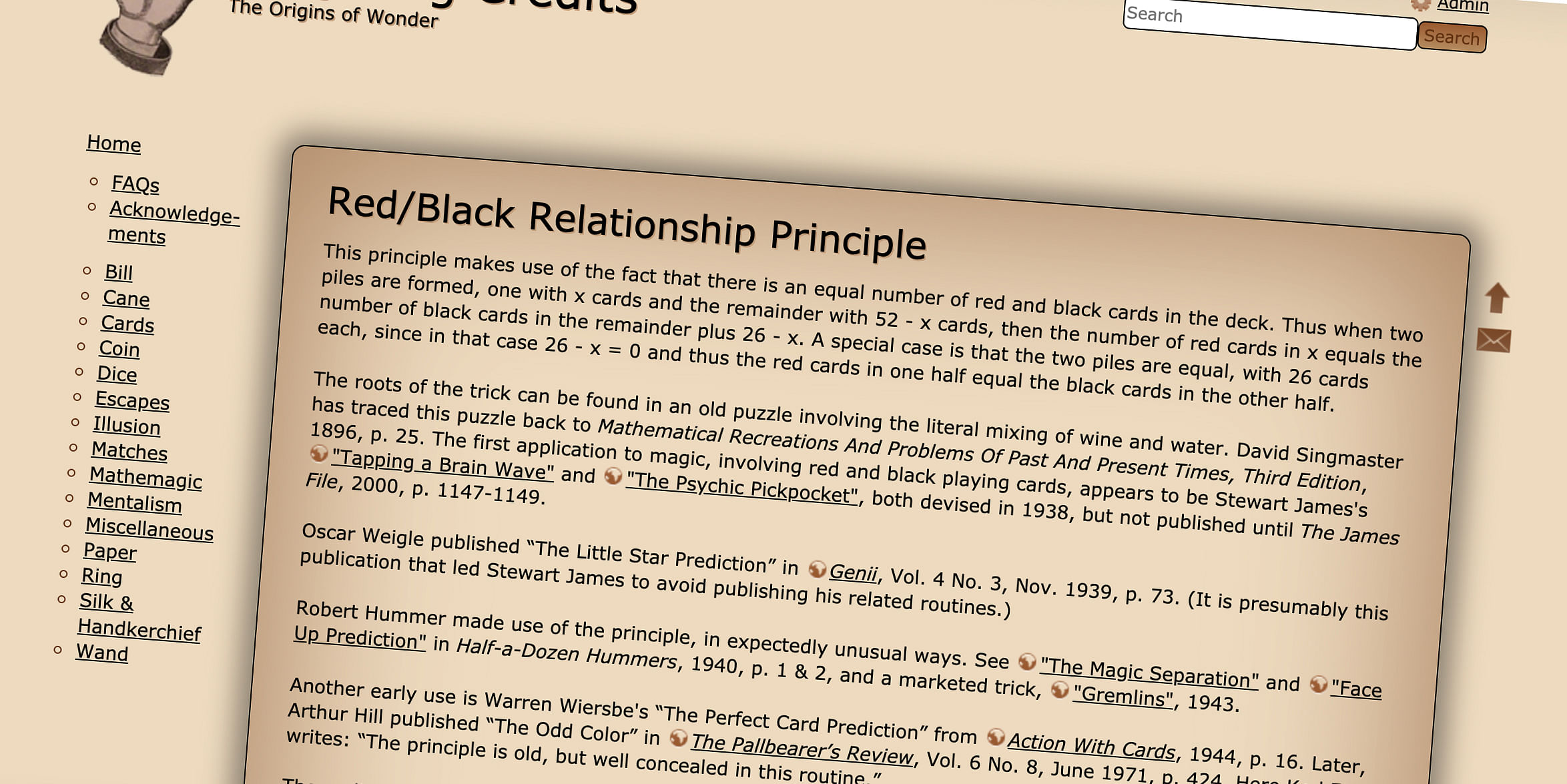The Red-Black Relationship Principle
By Matt Baker - Wednesday, August 12, 2020
This is the first installment of a new series of blog posts on mathematical magic tricks. In this inaugural post, I’ll talk about a deceptive principle which has the honor of having the worst name of any mathematical principle ever: the “red-black relationship principle”.
Let’s begin with a mathematical puzzle which has apparently been used as a job interview question at the high-tech company Yahoo:
“You are blindfolded and 10 coins are place in front of you on table. You are allowed to touch the coins, but can’t tell which side is up by feel. You are told that there are 5 coins head up and 5 coins tails up, but not which ones are which. How do you make two piles of coins, each having the same number of coins heads up?”
If you haven’t seen this before, please think about the puzzle for at least five minutes before reading on.
Seriously… I’ll wait.

OK, I’m back. The answer is: make two piles of 5 coins each and flip over all the coins in one of the two piles.
But why does this work? Well, I claim that when you initially separate the coins into two piles of 5 coins each (call them Pile A and Pile B), THERE ARE EXACTLY AS MANY HEADS-UP COINS IN PILE A AS THERE ARE TAILS-UP COINS IN PILE B.
Why? Well, the number of heads-up coins (call it x) in pile A plus the number of heads-up coins (call it y) in pile B is equal to 5. Also, since pile B has 5 coins and every coin is either heads-up or tails-up, the number of tails-up coins in pile B (call it z) plus the number of heads-up coins in pile B (which is y) is equal to 5. In other words, x+y=5 and z+y=5. Therefore, by high school algebra, x=z.
It follows that after we flip all the coins in pile B, there will be exactly as many heads-up coins in pile A as there are heads-up coins in pile B. Yahoo!!
This is closely related, by the way, to another old chestnut: the “water and wine puzzle” (whose roots can be traced back as far as 1556). You have two glasses, one filled with water and the other with wine. You pour one ounce of the water into the wine, stir, and then pour one ounce of the water-wine mixture back into the glass of water. Is there now more water in the wine glass or wine in the water glass?
The answer is that the two quantities are exactly equal. Quoting Martin Gardner (from his delightful essay “Modeling Mathematics with Playing Cards”):
“The simplest proof is to realize that, after the transfers, the amounts of liquid in each glass remains the same. So the quantity missing from the water is replaced by wine, and the amount of wine missing from the other glass is replaced by the same amount of water.”
Well said, Martin. The perceptive reader will notice that this is really the same argument we gave in our algebraic solution of the Yahoo interview puzzle. Martin just figured out a way to say it without using algebra.
A more difficult variation of the Yahoo puzzle, which has apparently been used as a job interview question at Apple (I guess you have to be smarter to work at Apple than at Yahoo), is the following:
“You have 100 coins lying flat on a table, each with a heads side and a tail side. 10 of them are heads up, 90 are tails up. You can't feel, see or in any other way find out which side is up. Split the coins into two piles such that there are the same number of heads in each pile.”
If you want to think about it before reading the answer, please do so now. Otherwise:
Answer: Split the coins into two piles, one with 90 coins and the other with 10. Flip over every coin in the pile with 10.
(Homework assignment: figure out why this works. Hint: use the same kind of algebra as above!)
Now, these are interesting puzzles, and being able to solve them can apparently get you a high-paying job in Silicon Valley. But what do they have to do with magic tricks, and why am I writing about them in a magic blog?

According to Conjuring Credits, the first applications of the red-black relationship principle (which I have just decided to rechristen "The Apple-Yahoo Interview Principle") to magic appear to be Stewart James’s “Tapping a Brain Wave” and “The Psychic Pickpocket”, both created in 1938 but not published until 2000, and Oscar Weigle's “The Little Star Prediction”, published in 1939. The earliest application of the “Apple” version, with unequal piles, is possibly “Cardini's Color Discernment” from Scarne on Card Tricks, 1950.
Here’s a simple card trick by Bob Hummer, called “The Magic Separation”, which makes use of the Yahoo version of the principle. The magician removes a packet of cards from the deck, turns some of the cards face-up, and asks the spectator to shuffle them into the face-down cards. The spectator can shuffle the packet further, so long as he doesn’t change the orientations of the cards. The magician announces that she will take the cards under the table and separate them into two packets each having the exact same number of face-down cards. She brings the cards under the table and in just a couple of seconds brings them back into view. The face-down cards are counted, and there are exactly the same number in each pile.
You know the method already: it’s just the Yahoo interview puzzle!
Here’s a more complex variation which I came up with myself, based on the Apple version of the principle rather than the Yahoo one. I like the method, but I don’t have a good presentation yet. Maybe readers of this blog can suggest one!
Give two spectators about half the deck each and let each shuffle their cards. Tell the spectators to (simultaneously) deal cards one at a time into a face-down pile, stopping whenever they like. The unused cards are set aside. One of the spectators is instructed to turn his pile face-up and then shuffle his face-up packet into the other spectator’s face-down packet. The other spectator cuts and completes. The magician announces that she will take the cards under the table (or under a cloth napkin on the table) and separate them into two packets each having the exact same number of face-down cards. In just a couple of seconds, she does exactly this. The effect is repeated a second time and the magician succeeds once again. The third and final phase begins the same way, but instead of flipping over one of the packets and then shuffling them together, each spectator cuts off about half of his packet and hands it to the other spectator; these packets are flipped face-up and shuffled by each spectator into his remaining face-down cards. One of the two remaining packets is flipped over and shuffled into the other one, and the spectators may now cut and complete the remaining packet. For the third time, the magician briefly brings the cards out of view and separates them into two packets, and each packet is found to have exactly the same number of face-down cards.
The method is as follows. In the first phase, focus on just one of the two spectators and count how many cards he deals down. Call this number X. Instruct the other spectator to flip his cards face-up. At the end of the first phase, when the cards briefly go out of view, take X cards from the top and flip them over, placing this packet onto the table next to the packet which was not flipped. Because of the red-black relationship principle (Apple version), the math will miraculously work out.
The second phase is the same as the first, although for the sake of variety it’s probably a good idea to add some extra “convincers”. For example, instead of just cutting and completing, you can have the cards cut into four piles and then let the spectators rearrange the piles in whichever order they choose. Or you can have the spectators “wash" the cards on the table, Vegas-style, after riffle-shuffling the packets together. (Just make sure not to alter the orientations.)
In phase three, I've added Simon Aronson’s “Cancellation Combination” (the mathematical basis of his trick Shuffle-Bored) as an extra subtlety. (Read Simon’s “Shuffle-Bored” manuscript, reprinted in the book Bound to Please, for further details on the mathematics underlying the Cancellation Combination.) Just remember, after each spectator has shuffled his face-up and face-down packets together, to ask the spectator whose cards you did not count to flip his packet over before shuffling the two packets together.
Some of my other favorite applications of the red-black relationship principle include:
- Simon Aronson’s “Point Spread”. Here is Simon’s introduction to the routine in his book Simply Simon: “This routine is one of my all-time pets. Its theme of magically conquering chance, of winning against fantastic odds, has an instant presentational appeal. It is baffling, to both laymen and magicians alike. It is refreshingly different from other card tricks, because two spectators actually play a card game. And it is virtually self-working.”
- Roberto Giobbi’s “Red and Black Intuition”, published in the August 2013 issue of Genii. In this routine, the red-black relationship principle is used during the course of a baffling demonstration to surreptitiously separate a shuffled deck into reds and blacks (for use in a follow-up trick such as “Out of this World”).
- “Hive Mind”, published in my book The Buena Vista Shuffle Club. In this routine, the spectators themselves make the prediction, in addition to performing all of the actions and making all of the choices. In my book, I wrote up “Hive Mind” as a coin trick, but I now prefer to do it with M&Ms of different colors. See my “At the Table” lecture for a performance of the M&M version, which also includes a neat way to display the prediction that isn’t explained in the book.
See Denis Behr’s Conjuring Archive for a number of other routines utilizing the Red-Black Relationship Principle.
Back to blog homepage
Similar posts on the blog:

